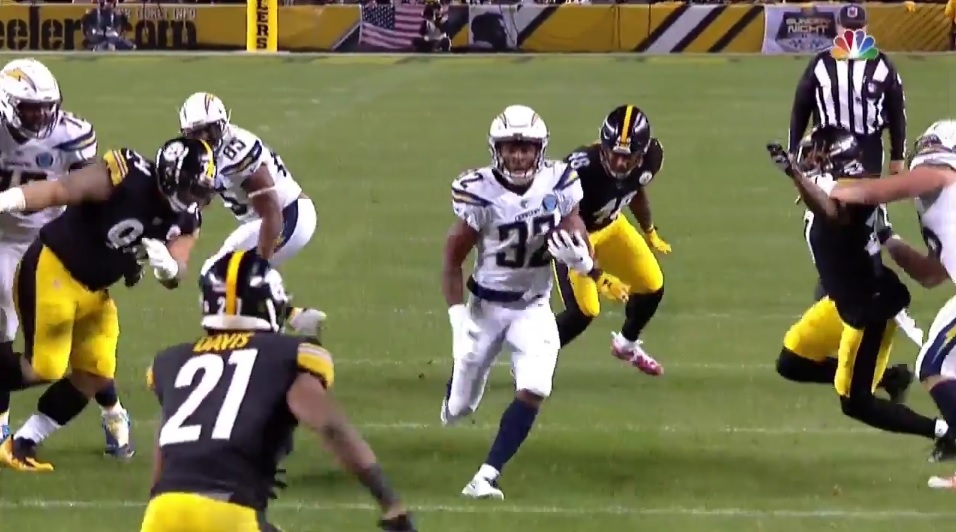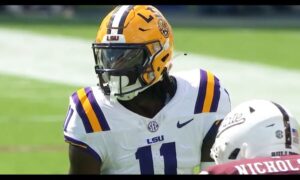I know I’m a little tardy getting around to this post. It’s one of my favorites but unfortunately, takes a little bit of time to sift through all the numbers. But I promised myself I’d share it once more before the regular season ends. Without further ado, the Pittsburgh Steelers’ defensive charting through the first 14 games.
Excluding kneeldowns and no plays, this is out of 907 defensive snaps.
– Your personnel groups for the season
Dime: 33.8%
Nickel: 32.7%
3-4: 32.2%
Goal Line: .5%
3-3-5: .4%
Dollar: .2%
Pittsburgh has run plenty of variations of these packages though. For example, a breakdown of their 3-4 looks, relative to the total 3-4 snaps played.
Base 3-4: 90%
3-4 Over: 3.8%
3-4 Big (three safeties, one corner): 2.7%
3-4 Small (three corners, one safety): 2.1%
3-4 Over Big: 1.4%
All told, they have 11 different groupings I’ve categorized this year, though the regular “over” front isn’t different from base in terms of personnel, only alignment. So ten, if you want to be technical about it.
It’s impressive to see how closely bunched the “Big Three”, 3-4, nickel, and dime are. Only a handful of snaps separate them. Dime packages have seen a considerable increase in recent weeks, though that can be partially attributed to teams playing catch up and throwing late (Chargers, Raiders).
– As we’ve said all year, the Steelers haven’t matched opposing personnel groupings as often in 2018 as the past, where they would do so basically 100% of the time. Against “passing personnel” (01, 10, 02, or 11), they have stayed in their base defense 9.6% of the time, 56 of a possible 583 snaps.
Against “run personnel”, they’ve remained in their sub-package even more, a whopping 25.4% of the time, 82 of 323 chances.
– So to sum up base vs sub, here’s how things look (we’re excluding goal line here).
Sub: 67.6%
Base: 32.4%
Still very much a “base” world, as you’d expect in 2018. Pittsburgh was in base 38% of the time last year.
– Let’s check in on Keith Butler and his blitz rates. Last time, we know the numbers, like your college roommate on 4/20, were very, very high.
They actually have come down slightly since midseason. He’s blitzing 44.9% of the time, down from 47.3% following the Carolina Panthers game Week 10. He’s eased off some of the late-game blitzing he’s liked to do in the past.
In the fourth quarter from Weeks 1 through 10, he blitzed 47.9% of the time. Since then, that number has dipped to 33.9%. One reason for the number seeing a dip though make no mistake, it’s still a career high.
However, he is sending 5+ rushes more often, climbing from 33% to 35.8%. So when he does bring the house, he’s a bit more aggressive about it than a “safe” four man pressure.
– Offenses are countering the Steelers when they go dime. They’re rushing for 5.1 yards per carry in those situations, about a full yard higher than what this defense allows overall. Some of that has come on third down but the numbers look worse on first and second down (5.8 YPC) so that’s not an excuse.
– Let’s look at this team by position group.
Defensive Line
– Yards per carry when on the field:
Stephon Tuitt: 3.5
Javon Hargrave: 3.6
Daniel McCullers: 3.7
Cam Heyward: 3.9
Tyson Alualu: 4.2
L.T. Walton: 4.7
Pressures
Cam Heyward: 28
Stephon Tuitt: 19
Javon Hargrave: 11
Daniel McCullers: 3
Tyson Alualu: 3
L.T. Walton: 1
And the all-important snaps per pressure. Lower the number, the better.
McCullers: 14.3
Heyward: 17.3
Hargrave: 18.5
Tuitt: 22.1
Walton: 23
Alualu: 47.7
General improvement for the main cogs. Heyward, Hargrave, and Tuitt have all seen their pressure numbers increase. McCullers, largely due to a small sample size, still tops the charts. Nice to see Hargrave get up to 11 pressures after beginning the season with very few – three in the first nine games.
Linebackers
– Jon Bostic averaged 43.3 snaps the first nine games. Since then? Just 26.6. Though it felt like he was a possible candidate as a three down linebacker, that’s what he did in Indy, he’s played on only 30 third downs all season, 24 of those were 3rd and 4 or closer.
Vince Williams and L.J. Fort have played 91 third down snaps.
Pressures
T.J. Watt: 34
Bud Dupree: 30
Vince Williams: 18
Anthony Chickillo: 8
Jon Bostic: 7
L.J. Fort: 4
Snaps Per Pressure
Williams: 6.4
Bostic: 6.7
Fort: 11.3
Watt: 12.1
Dupree: 13.5
Chickillo: 18.9
Pressure from the edge guys is down a little. Over the last five weeks, Watt only has eight while Dupree has just two (one was a sack though). Chickillo has just one. Want to see things turn around for the end of the year.
And one of my favorite stats, drop %.
OLB Drop/Coverage Rates
Dupree: 17.7%
Chickillo: 17%
Watt: 18.7%
Numbers continue to come down for Chickillo and Watt while staying nearly the same for Dupree. Remember, Watt dropped 37% of the time last year. Focus in 2018 is for him to rush the passer.
– Some target numbers to round out the unit:
Jon Bostic: 8/12 145 yards 0 TDs 1 INT
L.J. Fort: 8/11 110 yards, 0 TDs 0 INT
T.J. Watt: 4/8 40 yards, 0 TDs 0 INTs
Vince Williams: 3/8 42 yards, 0 TDs 1 INT
The last six of Bostic’s targets have been completed for 95 yards. He began the year 2/6 for 50 yards and the INT (tipped pass vs Tampa). That’s why he’s been removed from his coverage role.
Defensive Back
– Let’s check out those all-important target numbers.
Joe Haden: 23/48 280 yards, 1 TD 2 INTs
Coty Sensabaugh: 18/27 216 yards, 2 TDs 0 INT
Mike Hilton: 11/24 183 yards, 2 TDs 0 INT
Artie Burns: 15/21 239 yards, 4 TD 0 INT
Terrell Edmunds: 8/15 163 yards, 0 TD 1 INT
Sean Davis: 7/14 144 yards, 3 TD 0 INT
Morgan Burnett: 7/13 139 yards, 1 TD 0 INT
Cam Sutton: 7/11 105 yards, 1 TD 1 INT
Large spike in numbers for most of the players and overall, not for the better. Sensabaugh is better than Burns but when you look at the target numbers, it’s not that much better. Combined, they’re allowing QBs to complete 68.7% of their passes, 9.5 yards per completion, and six touchdowns to zero picks.
– No surprise that Mike Hilton leads the secondary with 11 pressures.






